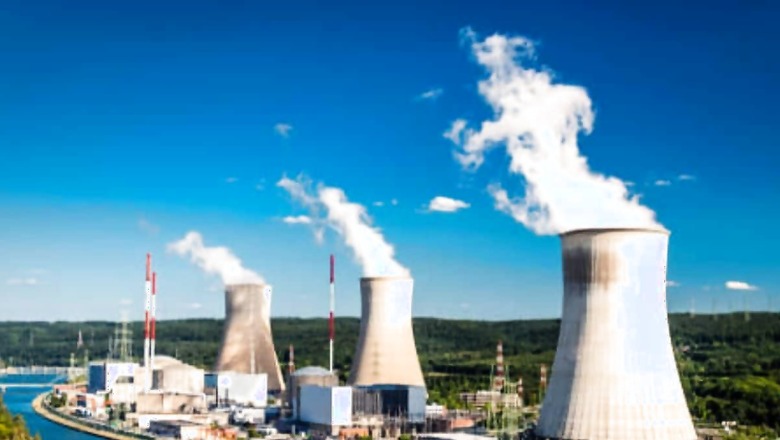
views
The Indian government is inviting private companies to invest a total of $26 billion in the country’s nuclear energy sector. This marks the first time New Delhi is seeking private participation in nuclear power, which currently contributes less than 2% of India’s electricity generation.
The government is in talks with five firms — Reliance Industries, Tata Power, Adani Power, and Vedanta Ltd. Each company is expected to invest around $5.3 billion. This investment aims to build 11,000 megawatts of new nuclear power generation capacity by 2040.
Currently, the Nuclear Power Corporation of India (NPCIL) owns and operates the existing nuclear power plants with a capacity of 7,500 MW and has committed investments for an additional 13,000 MW.
Private investment with public control. Here’s how it will work:
PRIVATE COMPANIES WILL TAKE THE LEAD
Financing: They will invest a total of $26 billion in building new nuclear power plants.
Project development: This includes acquiring land and water permits, as well as handling construction activities outside the reactor complex itself.
Nuclear Power Corporation of India (NPCIL) retains control of:
- Core operations: NPCIL will be responsible for building and operating the nuclear power plants, ensuring compliance with safety regulations.
- Fuel management: As mandated by law, NPCIL will handle the procurement and management of nuclear fuel for the plants.
- Revenue generation: Private companies will profit from the sale of electricity generated by the plants. NPCIL will receive a fee for operating and maintaining the facilities.
KEY CONSIDERATIONS
This innovative model complies with the 1962 Atomic Energy Act, which restricts private ownership of nuclear plants in India. A final approval from the Department of Atomic Energy is still required.
While private companies cannot own the plants, they can contribute significantly through financing, project development, and supplying equipment and components.
ADDRESSING PAST CHALLENGES
India’s history of falling short of nuclear capacity expansion goals is partly attributed to difficulties in securing fuel supplies. The 2010 agreement with the United States has helped alleviate this concern.
Stringent nuclear compensation laws previously hindered negotiations with foreign companies. The new model circumvents this issue by keeping core operations under NPCIL’s control.
This unique approach marks a significant shift in India’s nuclear energy strategy. By leveraging private investment and expertise while maintaining public control over critical aspects, India aims to accelerate nuclear capacity growth and contribute to its clean energy goals.
In addition to this domestic initiative, India is also forging international partnerships to bolster its nuclear ambitions. Last year, a collaborative effort with France was initiated to explore the development of small modular reactors and advanced nuclear technologies.
INDIA’S FRENCH CONNECTION
Last year, during Prime Minister Narendra Modi’s visit to Paris, India and France agreed to collaborate on developing small modular reactors and advanced nuclear technologies. They also welcomed progress on the long-delayed Jaitapur nuclear power project.
In January 2023, during President Macron’s visit to India, both nations revealed their efforts to establish a financing mechanism and localise components for the massive 9,900-megawatt Jaitapur plant in Maharashtra.
Foreign Secretary Vinay Kwatra confirmed ongoing discussions between French firm EDF and India’s NPCIL regarding the project’s financing and localisation aspects.
The Jaitapur project’s history includes:
2009: Initial MoU signed with French nuclear supplier Areva (later bankrupt)
2016: Revised MoU signed between EDF and NPCIL
2020: EDF submitted a technical and commercial proposal for the project
EDF’s plan involves supplying six state-of-the-art European Pressurized Reactors (EPRs), each with a capacity of 1,650 MW.
INDIA’S SMR PROGRAMME
Facing pressure from falling renewable energy prices, the nuclear industry is exploring a new strategy: small modular reactors (SMRs). Unlike traditional large reactors, which aimed to reduce costs through sheer scale, SMRs are designed for mass production, aiming to leverage economies of scale to bring down costs. Additionally, modular construction, where pre-fabricated reactors are shipped to the site, promises faster and cheaper installation.
The Indian government is particularly bullish on SMRs, envisioning them as a solution for both power generation and decarbonizing industries. These reactors, typically below 300 MW in capacity, are being explored by the National Thermal Power Corporation (NTPC) for retrofitting decommissioned coal plants. Furthermore, NITI Aayog, a government think tank, proposes SMRs as a clean energy source for industrial hydrogen production.
The potential scale is significant. India’s current coal-fired power plant capacity sits around 220 gigawatts (GW). Experts estimate that up to 20 GW of this capacity is already offline, with more plants expected to follow suit.
AK Nayak, head of the Nuclear Control and Program Wing at the Department of Atomic Energy, sees this as a prime opportunity for SMRs. He suggests retrofitting these decommissioned coal plants with SMRs, presenting a “business opportunity of 220 GW” for companies like NTPC.
However, the economic viability of SMRs remains a question mark. While SMR proponents, including the Indian government, claim significant cost and time savings, critics, including some within the nuclear industry, challenge these assertions.
A key concern is whether mass production can truly drive down reactor prices. Manufacturing cost reduction hinges on several factors, including cheaper material sourcing through bulk purchases and spreading fixed costs like R&D and assembly plant setup across a larger production volume.
The critical question is: how many reactors need to be produced for meaningful cost savings? Studies suggest that SMR costs might only reach parity with large reactors after manufacturing between 700 and 60,000 units, raising doubts about the economic feasibility of SMRs.
NUCLEAR ENERGY BACK ON THE TABLE
India boasts a pioneering history in developing nuclear energy, establishing the Indian Atomic Energy Commission in 1948. However, this journey has been marked by significant roadblocks.
For decades, India faced international isolation due to concerns about the dual-use nature of nuclear technology. This resulted in exclusion from crucial trade opportunities, hindering access to nuclear plants and components for civilian purposes until 2009.
Further challenges emerged in the form of incompatibility between India’s domestic laws and international conventions. Since 2010, this incompatibility has impeded the adoption of foreign technology, hindering India’s nuclear energy ambitions.
The consequence is starkly evident: India’s current installed nuclear energy capacity of 7,480 MW falls far short of its aspirations. This stands in stark contrast to earlier ambitious plans, such as the 43,500 MW target envisioned in 1960 for the year 2000.
Two major reasons for the renewed push are:
- The limitations of renewables alone: As the world grapples with ambitious climate goals, it’s becoming increasingly clear that solely relying on solar, wind, and other renewables won’t suffice in reducing our dependence on fossil fuels and achieving significant carbon emission cuts. A substantial increase in nuclear energy capacity is seen as crucial to bridge the gap. India, for instance, is aiming to triple its current nuclear energy capacity to 22,480 MW by 2031.
- Strategic considerations: Beyond immediate climate concerns, nations are recognizing the strategic importance of fostering a robust domestic nuclear industry. This not only involves developing indigenous nuclear technologies over time, but also nurturing a domestic ecosystem for manufacturing nuclear components, ultimately leading to greater self-sufficiency and advancements in the sector.
A NEW CHAPTER WITH PRIVATE PARTICIPATION
India’s foray into nuclear energy has been a tale of early promise and persistent challenges. Despite being an early mover in establishing its nuclear program, the nation’s ambitions have been hampered by international isolation, legal hurdles, and unrealized targets.
However, a new chapter is unfolding. In a bid to accelerate nuclear capacity growth and address climate concerns, India is making a strategic shift by inviting private companies to invest in the sector for the first time. This unprecedented move, coupled with the government’s continued focus on indigenous SMR development and international collaborations, signifies a renewed push towards harnessing nuclear power as a key player in India’s energy future.
While the path ahead is undoubtedly complex, navigating the intricacies of private participation, technological advancements, and international cooperation will be crucial in determining the success of this ambitious endeavor. The coming years will be watched closely as India strives to bridge the gap between its nuclear aspirations and the realities of a rapidly evolving energy landscape.




















Comments
0 comment